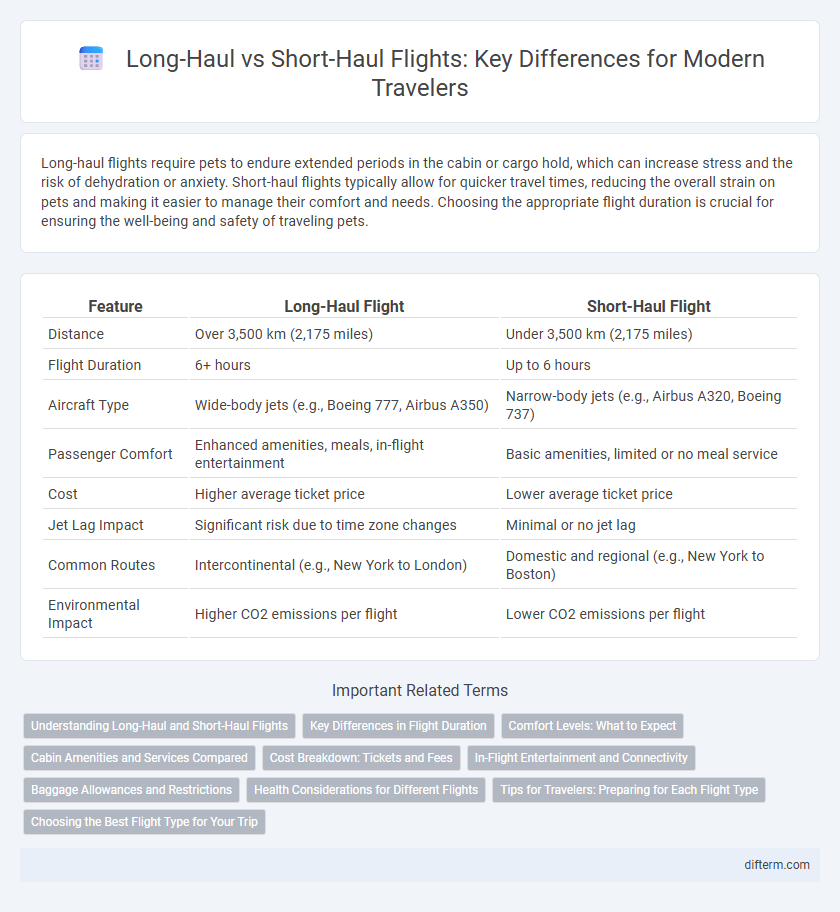Long-haul flights require pets to endure extended periods in the cabin or cargo hold, which can increase stress and the risk of dehydration or anxiety. Short-haul flights typically allow for quicker travel times, reducing the overall strain on pets and making it easier to manage their comfort and needs. Choosing the appropriate flight duration is crucial for ensuring the well-being and safety of traveling pets.
Table of Comparison
| Feature | Long-Haul Flight | Short-Haul Flight |
|---|---|---|
| Distance | Over 3,500 km (2,175 miles) | Under 3,500 km (2,175 miles) |
| Flight Duration | 6+ hours | Up to 6 hours |
| Aircraft Type | Wide-body jets (e.g., Boeing 777, Airbus A350) | Narrow-body jets (e.g., Airbus A320, Boeing 737) |
| Passenger Comfort | Enhanced amenities, meals, in-flight entertainment | Basic amenities, limited or no meal service |
| Cost | Higher average ticket price | Lower average ticket price |
| Jet Lag Impact | Significant risk due to time zone changes | Minimal or no jet lag |
| Common Routes | Intercontinental (e.g., New York to London) | Domestic and regional (e.g., New York to Boston) |
| Environmental Impact | Higher CO2 emissions per flight | Lower CO2 emissions per flight |
Understanding Long-Haul and Short-Haul Flights
Long-haul flights typically cover distances over 3,500 miles and last more than six hours, connecting major international hubs across continents, while short-haul flights operate within shorter distances, usually under three hours, serving regional or domestic routes. The operational differences impact aircraft types, in-flight services, and passenger comfort, with long-haul flights often featuring wide-body jets and enhanced amenities to accommodate extended travel time. Understanding these distinctions helps travelers plan effectively for factors like jet lag, baggage allowances, and transit logistics.
Key Differences in Flight Duration
Long-haul flights typically exceed 6 hours and cover distances over 3,000 miles, connecting continents or distant international destinations, whereas short-haul flights generally last under 3 hours and cover regional or domestic routes within 1,000 miles. The extended duration of long-haul flights necessitates additional amenities such as in-flight meals, entertainment, and enhanced comfort measures, while short-haul flights prioritize quick boarding and minimal services. Airlines schedule long-haul flights for less frequent but prolonged journeys, contrasting with the higher frequency and faster turnaround times seen in short-haul operations.
Comfort Levels: What to Expect
Comfort levels on long-haul flights often include fully reclining seats, in-flight entertainment systems, and multiple meal services, catering to extended travel durations. Short-haul flights typically offer more basic seating arrangements with limited legroom and fewer amenities, prioritizing quick turnover and efficiency. Passengers should prepare for potential discomfort on short flights due to cramped seating and limited movement opportunities.
Cabin Amenities and Services Compared
Long-haul flights typically offer enhanced cabin amenities such as lie-flat seats, in-flight entertainment systems, and premium meal options, providing greater comfort over extended travel durations. Short-haul flights often feature basic seating and limited meal services, prioritizing efficiency and quick turnaround times. Airlines may provide complimentary beverages and snacks on short-haul routes, whereas long-haul flights include comprehensive services like amenity kits, multiple meal courses, and personalized entertainment choices.
Cost Breakdown: Tickets and Fees
Long-haul flights typically have higher base ticket prices due to extended distance, fuel consumption, and crew costs, often comprising 60-70% of the total airfare. Short-haul flights usually incur lower ticket costs but may have proportionally higher fees for services like baggage, seat selection, and airport taxes, which can amount to 20-30% of the overall price. Airlines apply different pricing strategies based on route length, demand, and operational expenses, significantly affecting the cost breakdown between long-haul and short-haul flights.
In-Flight Entertainment and Connectivity
Long-haul flights typically offer a wider range of in-flight entertainment options, including personal seat-back screens with extensive movie libraries, TV shows, and games, as well as Wi-Fi connectivity for browsing and messaging. In contrast, short-haul flights often have limited or no personal screens, relying mainly on streaming services accessible through passengers' devices if Wi-Fi is available. The availability and quality of connectivity on long-haul routes generally surpass short-haul flights, enhancing the overall passenger experience during extended travel periods.
Baggage Allowances and Restrictions
Long-haul flights typically offer higher baggage allowances, often permitting two checked bags weighing up to 23 kg each, while short-haul flights usually restrict passengers to one checked bag with lower weight limits around 15-20 kg. Airlines on long-haul routes may allow larger carry-on dimensions and additional personal items compared to the stricter, more compact cabin baggage restrictions on short-haul flights. Understanding airline-specific policies and the variation in baggage fees is essential for optimizing packing strategies and avoiding unexpected costs during travel.
Health Considerations for Different Flights
Long-haul flights pose increased health risks such as deep vein thrombosis and dehydration due to prolonged immobility and cabin pressure, requiring passengers to stay hydrated and move regularly. Short-haul flights typically involve less physical strain but can still cause jet lag and mild discomfort without proper rest and hydration. Understanding these differences helps travelers prepare with appropriate health measures tailored to flight duration and conditions.
Tips for Travelers: Preparing for Each Flight Type
Pack essentials differently for long-haul flights, including noise-canceling headphones, compression socks, and sleep aids to manage fatigue and discomfort on extended journeys. Short-haul flights require efficient packing with easy access to travel documents, snacks, and entertainment to maximize comfort during brief travel periods. Travelers should adjust hydration and movement based on flight duration, ensuring frequent stretching during long flights and quick comfort measures for short trips.
Choosing the Best Flight Type for Your Trip
Long-haul flights typically cover distances over 3,500 miles and offer more in-flight services and amenities, making them ideal for intercontinental travel. Short-haul flights, usually under 1,500 miles, provide quicker transit times and more frequent schedules, suitable for regional trips or business travel. Evaluating factors such as trip duration, comfort preferences, and budget can help travelers choose the best flight type for their specific travel needs.
long-haul flight vs short-haul flight Infographic

 difterm.com
difterm.com